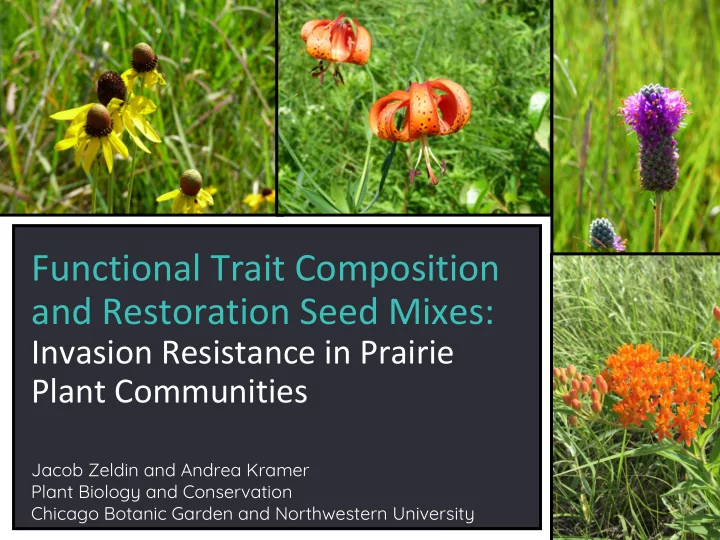

Functional Trait Composition and Restoration Seed Mixes: Invasion Resistance in Prairie Plant Communities Jacob Zeldin and Andrea Kramer Plant Biology and Conservation Chicago Botanic Garden and Northwestern University
Background Invasive Plant Species are a major driver of global change and substantially affect recipient communities. Resisting invasion is a key restoration goal. Community Diversity is a characteristic thought to increase invasion resistance. Maximizing Diversity in seed mixes could reduce invasion in resulting restorations.
Components of Biodiversity Number/Evenness of species “Types” of species Modified from Swenson, 2011
A Note on Functional Traits
Functional diversity operates to resist invasion through Resource Pre-emption LIMITING SIMILARITY COMPLEMENTARITY
Invasion resistance may decrease with increased availability of limiting nutrients
Application: Restoration Seed Mixes When addressing invasion suppression as a restoration goal, should seed mixes: Only maximize species Also consider functional richness and diversity? diversity and composition?
Hypotheses 1) Biomass of invaders will be lower in communities with high functional diversity (Complementarity). 2) Biomass of invaders will be lower in communities with mean functional traits similar to those of invaders (Limiting Similarity). 3) Effects of complementarity and limiting similarity on resistance to invasion is less pronounced or absent in nitrogen addition treatments.
Methods 24 Communities X 2 Invasion Treatments 1) Stratification/Germination X 2) Planting Communities 2 Nitrogen Treatments = 3) Invading with Bromus inermis 96 Replicates & Melilotus officinalis www.pittstate.edu 4) Bi-weekly N additions 5) 9 Weeks of Growth 6) Harvest Biomass (Dry and Weigh)
Bromus – Complimentarity Model Functional diversity, community biomass, and species richness significantly affect Bromus biomass (F = 9.91 on 4 and 33 d.f, p < 0.001)
Melilotus – Complimentarity Model Only community biomass predicted Melilotus biomass F = 12.6 on 1 and 34 d.f, p < 0.005
Bromus - Trait Models L. Thickness F = 5.49 on 2 and 35 d.f, p < 0.05 LIMITING SIMILARITY Height SLA
Melilotus- Trait Models SLA F = 14.1 on 1 and 34 d.f p < 0.001 LIMITING SIMILARITY Height L. Thickness
Hypotheses 1) Biomass of invaders will be lower in communities with high functional diversity (Complementarity). No, but evidence of an opposite trend in Bromus invaded treatments. 2) Biomass of invaders will be lower in communities with mean functional traits similar to those of invaders (Limiting Similarity). Yes, there is evidence for limiting similarity. 3) Effects of complementarity and limiting similarity on resistance to invasion is less pronounced or absent in nitrogen addition treatments. No. There was not enough evidence to suggest an effect of Nitrogen.
Conclusions In this experiment, FD had a positive • ( Bromus ) or no effect ( Melilotus ) on invader biomass. Complementarity may not be driving invasion resistance. This could be explained by low species • richness. Relationships could change in later life • stages and at higher plant densities Future studies should test similar • hypotheses at larger scales in the field and should manipulate species richness and density.
Conclusions My results suggest that limiting • similarity may be constraining invader success. Early restoration efforts may benefit • from seed mixes containing species with traits similar to those of potential invaders. Future studies should investigate the • tradeoffs of increased invasion resistance and the saturation of potentially dominant native species. Nitrogen addition may require longer • time-spans or more intense resource competition to impact invasion.
Acknowledgments I would like to thank: Andrea Kramer, Evelyn Williams, and • Jeremie Fant for advising in experimental design and implementation. Alex Seglias, Olga Kildisheva, Abbey • White, and others for their assistance with biomass harvest and data collection. The Kramer-Havens lab group for • feedback and insight. Don Waller and the Plant Ecology • Laboratory of the University of Wisconsin – Madison for allowing the use of their plant functional trait database * NSF Dimensions of Biodiversity program supported collection of these trait data (DEB-1046355) The NSF Research Experience for • Undergraduates program and our intern Wendy Semski for help over the growing season.
Questions? References and Attributions • Funk, J. L et. al . 2008. Trends in Ecology & Evolution 23:695–703. • Swenson, N. G. 2011. American Journal of Botany 98:472–480. • Tilman, David. 2001. Encyclopedia of Biodiversity. Academic Press, San Diego, CA
The preceding presentation was delivered at the 2017 National Native Seed Conference Washington, D.C. February 13-16, 2017 This and additional presentations available at http://nativeseed.info
Recommend
More recommend